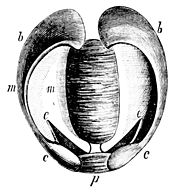backward within the anterior, spiral parts of the valves (Fig. 11, p) below the line which passes by the two tuberculous extremities, coupled together, i. e., by the centre of rotation of the valves. From this principal mass some slender muscular fibres extend over the two thorny protuberances (Fig. 11, e e),
which may be compared to two arms of levers, whose common fulcrum is found in the centre of rotation of the valves. It is clear that, by this arrangement, the action of the muscle is considerably strengthened.
The two adductor muscles are composed of the same microscopic elements, that is, of fibres and fibro-cellular tissue, easily separated in form of a ribbon, six mmm. wide and one mmm. thick; their length is relatively considerable, and probably equal to that of the muscles themselves, inasmuch as one can nowhere discover any free extremities. These fibres are distinguished from the fibro-cellular tissue of the mantle not only by their greater length, but also by their darker outlines, which indicate thicker walls and, consequently, greater solidity and strength.
The effect produced by these muscles in contracting is very evident. The large adductor muscle, situated on a plane a little above the general centre of rotation of the valves, serves to draw together the rounded sides of the valves as well as all the other parts of the valves situated posteriorly on the same side of the centre of rotation. The small adductor muscle, placed in front of the centre of rotation, exercises a more limited action. When it contracts, the anterior extremities of the spiral part of the valves approach each other; simultaneously, all the parts of the shell situated behind experience a slight displacement forward, as if they tried to turn about an axis passing by the centre of rotation; but the one which they thus describe is necessarily very small, on account of the shortness of the muscle. It is evident that the direction of the movement made by one of these adductor muscles is nearly a right angle with that of the other; the anterior and middle parts of the valves, which are first acted upon by the action of the muscles, meet at an angle of 90°.
Finally, the teredo has also a muscular organ, without which it would be impossible for him to pierce his galleries. It is the part known as the foot, which has the power of projecting outside between the anterior opening of the valves (Fig. 5, b; Fig. 1, d—the dotted line indicating the outline of the foot in the state of extension). This foot has the power of extension and retraction, and terminates at the end with a suction-disk, by the aid of which the animal can attach itself to the wood.
From what precedes, it is evident that the teredo, far from being,

